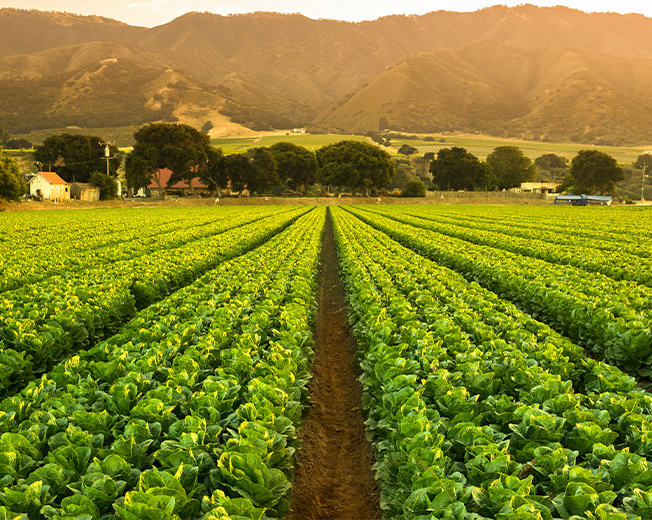
Agricultural land in Spain 2023
Reports
Jan 23, 2024

- In 2023, the value of agricultural land will increase for most crops, despite adverse climatic and economic conditions.
- Increases in land values are concentrated on farms with access to water and crops with potential for processing.
- The crops that have generated the highest returns in the last 5 years, according to Tinsa appraisals, have been dryland fruit crops (+3.4%) and irrigated herbaceous crops (+2.8%).
- Rising cereal prices due to the war in Ukraine, the recovery in demand for stone and pome fruits, and the increase in lemon cultivation compared to oranges are among the trends for 2023.
- The prolonged drought is driving the search for techniques that allow for efficient water use, and some farms are beginning to be converted from irrigated to dryland.
Performance of the agri-food sector in 2023
Drought and altered weather patterns have led to a reduction in production in 2023 in an agricultural sector that had already been penalized by marked inflation in production costs since 2021. However, in most cases, lower harvests have allowed higher production costs to be passed on to food prices. This has helped limit the impact of this situation on farm returns. Consequently, land prices have generally remained stable, with moderate increases for some crops, generally more pronounced in irrigated crops.
Herbaceous Crops
High food prices due to a poor harvest affected by prolonged drought and adverse weather conditions, coupled with a further increase in grain prices due to disruptions in international trade caused by armed conflicts in Europe, have increased the returns generated by arable crops in 2023. However, the medium-term outlook shows that arable crops have been declining in some areas of Spain for several years due to their low profitability. There is a trend toward converting farms from dryland arable crops (wheat, barley, or oats) to other more profitable crops (generally woody crops, such as vines, olive groves, or fruit trees). This is also driving up land prices, and over the last five years, arable land has increased in value by +2.8% in the case of irrigated land and +1.7% in the case of dryland land.
Olive Grove
In 2023, olive production has been severely affected by early high temperatures that compromised fruit formation. However, for now, this is an isolated incident that has not affected land values. The stability of olive oil consumption in Spain over the last decade guarantees a stable income and makes olive groves perceived by farmers as a "safe haven." Over the last five years, the value of land used for olive groves has grown by +1.2% in irrigated land and +0.2% in dry land.
Vineyard
The lower wine consumption since the pandemic has impacted the value of land used for vineyards in some areas, although overall it remains stable. The volatility of production due to its sensitivity to climate, coupled with rising production costs that have not been fully passed on to final prices, is increasing pressure on crop yields and driving the vineyard sector toward a shift from dryland to irrigated land, using intensive and super-intensive methods. The value of land used for vineyards has grown by +1.1% in irrigated land and +1.9% in dry land over the last five years.
Fruit Trees
Stone and pome fruit trees are showing signs of recovery after years of reduced sales due to a shift in consumer preferences toward other fruit varieties, such as tropical fruit. This recovery in demand, coupled with reduced production due to the impact of climate change and prolonged drought, has led to improvements in crop profitability over the last year.
Meanwhile, nuts are showing signs of moderation due to stagnant almond prices, although pistachio prices continue to drive growth. Tropical fruit production is compromised by water scarcity. Overall, the value of land used for fruit trees has increased by +3.4% in the last 5 years under dryland conditions and has remained stable (-0.6%) under irrigated conditions.
Citrus Fruits
Competition from imports, coupled with the impact of climate change and drought, which are reducing production, is exacerbating the lack of generational turnover and fostering a trend toward vertical integration of farms to optimize costs. This has led to a dynamic sale and purchase of citrus farms, driving their value upward.
The value of land used for citrus fruit has increased by 1.0% over the last 5 years.
Vegetables and Greenhouses
In general, these are highly optimized and export-oriented crops, which has reduced the impact of drought and asymmetric competition from imports on production.
Growing water restrictions in several areas due to the drought are driving the abandonment of this water-intensive crop and its conversion from horticultural farms to dryland cereals.
Thus, the value of land used for vegetable crops over the last 5 years has grown by 1.7% outdoors and by 1.1% in greenhouses.
Meadows, Pastures, and Grasslands
The overall value of pastures has decreased slightly in the last two years due to drought, which has reduced production, and the abandonment of land in some areas.
However, in several areas, the value has remained stable or increased slightly thanks to livestock activity. Rising prices for grain and feed have led livestock farmers to turn to pastures to supplement livestock feed and reduce costs.

Download the Full Report
Leave us your details to access the full report.
